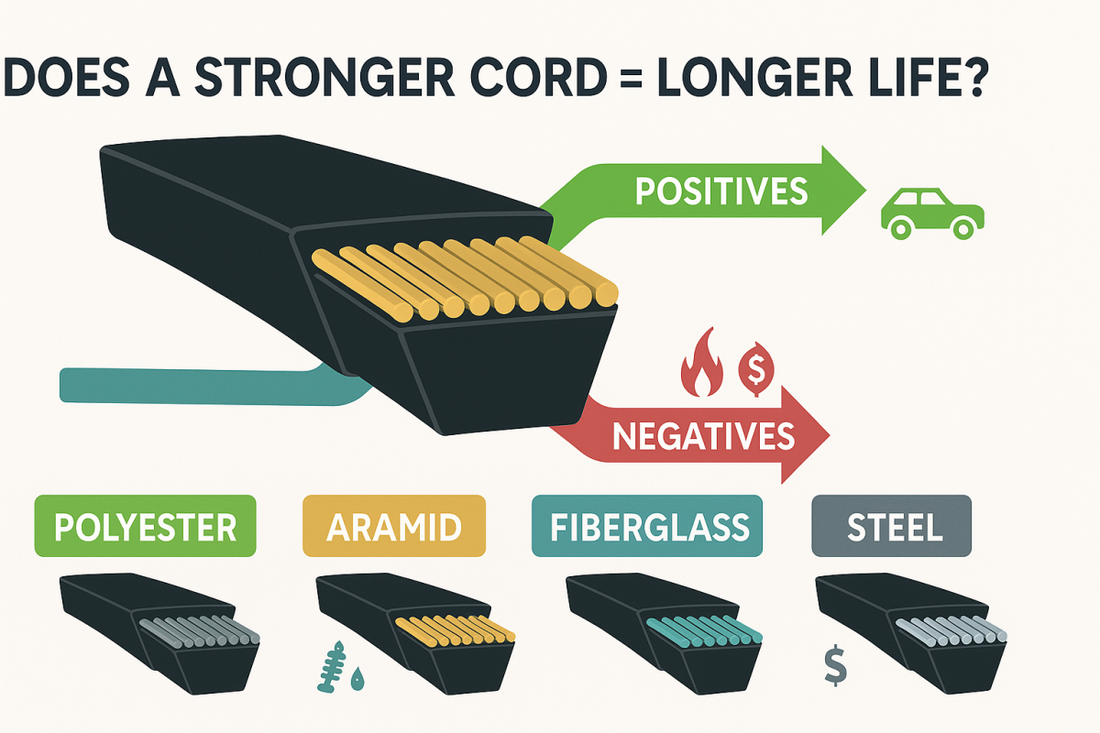
Do Stronger Tensile Strength Cords Make V-Belts Last Longer?
Share
The Quick Take for those who are in a hurry
- Higher tensile strength does not equal automatic longer life. Cord strength is just one variable in a complex system.
- Stronger cords shine on high shock, high horsepower, or long center drives where stretch control is critical.
- They can backfire on tight radius serpentine routes or poorly aligned drives, cracking sooner than standard belts.
- Rubber compound, cord rubber adhesion, tensioning, and contamination often dictate real world lifespan more than raw tensile numbers.

The Positives — When Stronger Cords Pay Off
1. Shock Load Survival
- Balers, grinders, rock crushers hammer belts with torque spikes. Aramid or fiberglass cords absorb the hit without permanent stretch.
2. Length Stability on Long Center Drives
- When centers exceed 2 m, re tensioning downtime costs more than a premium belt. Low stretch cords hold pitch length, keeping power transfer efficient.
3. Higher Power in the Same Space
- Wedge or narrow “XP” profiles can transmit 30–50 % more HP when cord tensile and modulus go up, letting designers downsize sheave diameters.
4. Heat Resistance Synergy
- High tensile belts often pair with EPDM or HNBR rubber rated 120 – 150 °C, delaying glaze, slip, and hardening.
The Negatives — Hidden Trade-Offs
1. Bending Fatigue on Small Sheaves
- Ultra stiff cords resist elongation but hate tight radii. In drives where pitch diameters fall below the belt’s minimum, cracks start at the cord rubber interface.
2. Higher Sidewall Stress
- A stiffer belt can wedge more aggressively, boosting sidewall pressure and heat. Without matching sheave groove quality, sidewall glazing shortens life.
3. Cost vs. ROI
- Aramid belts often run 2–4× the price of polyester. If the failure mode is contamination or misalignment, spending more on tensile buys zero extra hours.
4. False Sense of Security
- Users may skip tension checks because the belt “won’t stretch.” Most tensioned belts slip, overheat, and fail despite heroic cord strength.
Decision Matrix: Should You Upgrade?
| Application Condition | Stay with Standard Polyester | Upgrade to Aramid/Fiberglass | Go Steel-Cord |
| Pulley diam. < 3 in / 75 mm | ✅ | ❌ | ❌ |
| Frequent shock loads | ⚠️ | ✅ | ⚠️ |
| Temp > 110 °C | ⚠️ | ✅ | ✅ |
| Center distance > 2 m | ⚠️ | ✅ | ✅ |
| Abrasive dust / grit | ⚠️ (focus on cover) | ⚠️ | ✅ |
| Budget sensitive | ✅ | ⚠️ | ❌ |
Legend: ✅ Best fit ⚠️ Possible with caveats ❌ Generally avoid
Installation & Maintenance Still Rule
- Set tension to spec with a Krikit II or sonic gauge.
- Check alignment — even 0.5° mis-parallel cuts belt life ≥ 25 %.
- Match sheave condition: < 0.001 in run-out; groove depth per RMA standard.
- Reinspect after 24 hours; re-tension if deflection dropped > 15 %.
- Keep guards in place to block oil, coolant, and abrasive fines.
Pro tip: A mid grade polyester belt on a perfectly aligned, well-tensioned drive often outlasts an aramid belt on a dirty, mis-tensioned one.
Key Takeaways for Buyers & Maintenance Teams
- Stronger cords extend life only when the primary failure mode is stretch or tensile overload.
- If your belts die from cracking, glazing, or contamination, focus on rubber compound, cover design, and drive setup first.
- Run a pilot test: install one high tensile belt alongside standard belts under identical loads. Track hours to failure before switching fleet-wide.
- Balance cost vs. downtime. On critical drives where an hour offline costs thousands, premium belts pay back fast.

